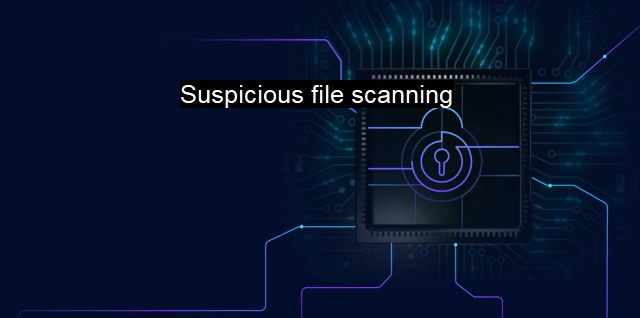What is Suspicious file scanning?
Securing the Digital Realm: The Importance of Suspicious File Scanning in Cybersecurity Protection
Suspicious file scanning is a crucial process embedded within cybersecurity measures that specifically locates and scrutinizes data that may pose security threats to computer systems. It is a function often associated with robust antivirus software and is decidedly imperative in maintaining the integrity of hardware and software infrastructure, as well as securing and safeguarding user data.Suspicious file scanning forms part of the broader framework of vulnerability scanning that is the process of detecting, identifying, and quashing potential threats and security breaches on a computer system's network. A suspicious file scan primarily focuses on detecting and analyzing suspicious or unexpected files within a system's infrastructure. These files could harbor viruses or other malware that could compromise the integrity, functionality, and security of the entire system.
The root of these suspicious files could be spam emails, malicious websites, harmful software or apps that manage to creep into the system unnoticed. Regularly conducted suspicious file scanning could help in advancing the security posture of an organization by quickly identifying these potential threats before they progress into a major cyberattack. This preemptive strategy eventually lowers the risk of exploitation of proprietary data and minimizes potential financial losses.
The technology of suspicious file scanning is exceptionally intricate. It leverages an array of algorithms, programmed instructions, and machine learning to execute dynamic analysis of files, enhancing the virus or malware detection process. The scan certifies that the data present within a file replicates its assigned actions without any illicit background activities.
This cybersecurity measure can be manual or automatic. Manual file scanning requires a user to orchestrate the scan, whereas automatic scanning is pre-scheduled. Reduxing the burden from users, automatic scanning ensures that the system is thoroughly scanned for suspicious files at regular intervals, thus ensuring round-the-clock surveillance.
Suspicious file scanning isn't merely diagnosing files for potential threats; it is about acting in retaliation once a threat has been identified. Advanced antivirus software employs a heuristic scanning mechanism to encounter the broad array of ever-evolving cyber threats, continually nurturing its database to furnish the software with newfound knowledge on malware.
Antivirus engines are incorporated with a quarantining feature that distances these suspicious-acting files, preventing them from interacting with, thus possibly corrupting, secure files and folders. The isolation system aids in limiting the assessment of these files in a controlled environment, where there are diminished risks of a system-wide infection.
Ominously, malicious attacks are growing exponentially sophisticated and relentless in this yesteryears' era of technology. They fatigue legacy antivirus scans with engineered evasion techniques. Their potency to damage is accentuated when the received file is from a recognizable, trustworthy source, leveraging this familiarity to slip under the radar undetected.
Notably, the modern, advanced cloud-based models offer real-time file scanning. The software maintains a hash database of known suspicious files. Any incoming files are hashed and compared with the already established database. Therefore, any suspicious incoming file is critically diagnosed before entering the system.
Suspicious file scanning is invaluable for individuals and organizations alike. It acts as the first layer of defense against malicious threats and equips users with secure browsing and working experience, ensuring that the digital space is safe. Suspicious file scanning strikes a harmonious balance between computing efficiency and security, proactive and reactive analysis, and, more significantly, between malware detection and user privacy. Thus, it forms the epicenter of the cybersecurity world, diligently fighting off the persisting menace of cyberattacks.

Suspicious file scanning FAQs
What is suspicious file scanning and why is it important in cybersecurity?
Suspicious file scanning refers to the process of analyzing files for signs of malicious behavior or code. This is important in cybersecurity because it allows antivirus software to identify and quarantine potentially harmful files before they can cause damage to a computer or network.How does suspicious file scanning work?
Suspicious file scanning works by comparing the contents of a file to a database of known malware signatures and behavioral patterns. If the file matches any of these known indicators of malicious activity, it is flagged as suspicious and further analysis is performed. Some antivirus software also use heuristics, machine learning, and other advanced techniques to detect previously unknown or "zero-day" threats.What types of files can be scanned for suspicious activity?
Antivirus software can scan a wide variety of file types for suspicious activity, including executable files (.exe), Microsoft Office documents (.doc, .xls, .ppt), PDFs, compressed files (.zip, .rar), and more. Some antivirus software can also scan network traffic and emails for signs of malware.Is suspicious file scanning enough to protect my computer from all cyber threats?
While suspicious file scanning is an important component of cybersecurity, it is not foolproof and cannot protect against all types of cyber threats. Other measures such as keeping software updated, using strong passwords, and practicing safe browsing habits are also important to reduce the risk of cyber attacks. Additionally, some sophisticated malware may be able to evade detection by antivirus software, so it is important to remain vigilant and alert for signs of suspicious activity on your computer.| | A | | | B | | | C | | | D | | | E | | | F | | | G | | | H | | | I | | | J | | | K | | | L | | | M | |
| | N | | | O | | | P | | | Q | | | R | | | S | | | T | | | U | | | V | | | W | | | X | | | Y | | | Z | |
| | 1 | | | 2 | | | 3 | | | 4 | | | 7 | | | 8 | | |||||||